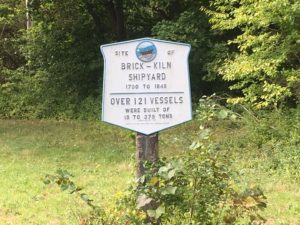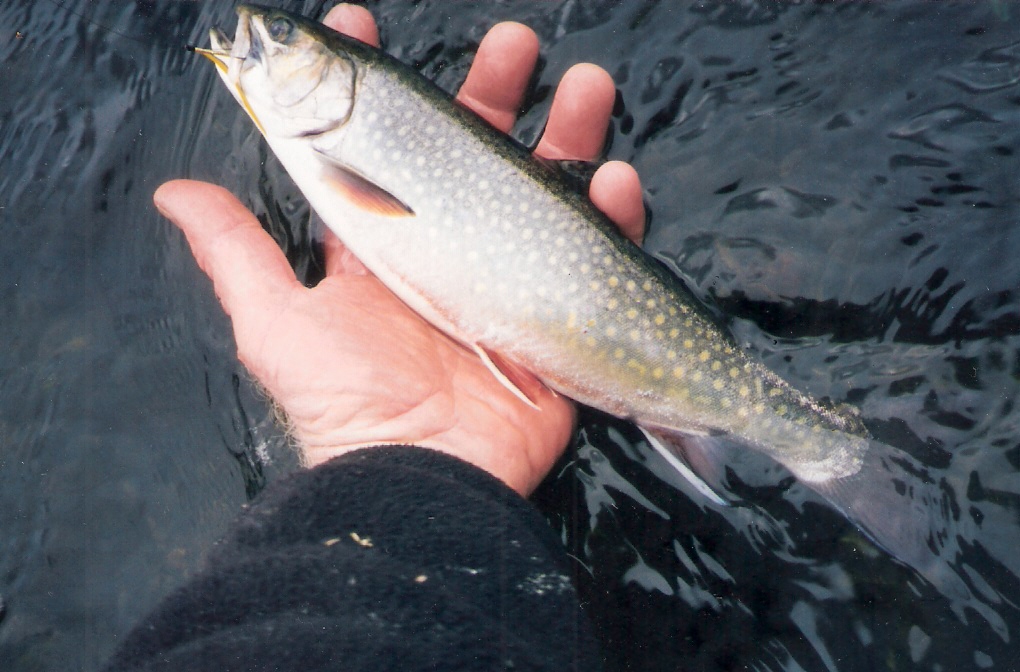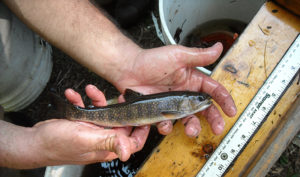By Warren Winders, Southeastern Mass. Trout Unlimited
The Watershed’s Spring Pageant

The pageantry of spring arrives as a feast for our senses long starved by the grey months of winter. The hardwoods flower and paint the hillsides with their soft hues of purple, red and green, punctuated here and there by the white blooms of dogwoods. In the wet swales and streamside bogs, peepers fill the evening air with their high, ecstatic singing, while mayflies dance in the sky above the stream, and red-winged blackbirds trill to each other from the cattails of the marsh. Waterfowl and shorebirds arrive from the south while vast, bright schools of herring and shad swim into the river from the sea.
Spring has arrived and nature’s abundance is everywhere to be seen and heard – as trout migrate to the watershed in tank trucks.
It’s tempting to think that, after centuries of overfishing and habitat destruction trout have trained people to raise them, feed them, and then carry them to the river to be released just in time for the bounty of spring’s aquatic insect hatches. Of course, we know, even if it might look that way to a visitor from another planet, that this is not the case. We’re the ones in control here; although, if we hadn’t built so many dams and filled the rivers with our effluents, we wouldn’t need to go to so much trouble and expense just to do a little trout fishing. And while we’re pondering whether or not we’ve been duped by trout (they’ve been fooling me for decades), we might consider that we have been trained, in a thoroughly Pavlovian fashion, to arrive at the water as soon as possible after the hatchery truck has dumped its load of trout. And, sadly, we’ve pretty much forgotten that things used to be different. Wild brook trout were once as much of a participant in the watershed’s spring pageantry as are the shad, herring, and trilling red-winged blackbirds that we see today. That we forget these things over time is a phenomenon known as the “sliding baseline.” Said another way, “You don’t know what you’ve got till it’s gone,” and then you forget about it within a couple of generations.
About Trout

I’ll begin by admitting that I enjoy fishing for the hatchery trout that the state puts into the streams and mill ponds of the North and South Rivers watershed – even though I know that they aren’t the real deal. Henry David Thoreau said that fishing is about more than just the fish. Standing in a stream on a sun-drenched spring day is the ideal place to experience the watershed’s spring pageant. In part, because I like to fly fish, I enjoy watching the stream’s aquatic insects as they cycle through their spring emergences. Stoneflies, caddisflies, and mayflies seem like old friends as they flutter about the stream and go about their business of mating and laying eggs. Their persistent and timeless return from one spring to the next, and down all the springs that I’ve known, is a comfort. They at least remain wild, as are the ducks that erupt from the stream when I get too close, and the ospreys that circle overhead. And then there’s the tug of a trout taking my fly….
From John Rowe’s Diary
“…at Pembroke, May 20, 1769, April 30, 1770, and May 5, 1773, each time catching fifty, fifty-eight, and sixty trout.”

John Rowe was a wealthy Boston merchant and an avid fisherman. At least one of his ships, the Beaver, was built on the North River, so he was familiar with the watershed. But Rowe didn’t need an excuse, like checking up on the progress of a ship, to go fishing. He fished coastal streams all along the South Shore and on Cape Cod, and he caught a lot of trout. The trout that Rowe caught were brook trout. While similar to trout, brook trout, Salvelinus fontinalis, are not really a trout, they are a char and are related to Arctic char, lake trout, bull trout and Dolly Varden. The chars are most easily identified by their having light-colored spots over a dark background, unlike trout, like rainbows and browns, that have dark spots over a lighter background. At the time that John Rowe was jotting down his catches in his diary, brook trout were the only char, or “trout”, to be found in Massachusetts, and they were still, as we see from Rowe’s diary, abundant in the North and South Rivers watershed.
Most of the brook trout that John Rowe caught exhibited an anadromous life history, which is to say that they were known to migrate out of their freshwater streams into tidewater for periods of time, and then as conditions – usually things like temperature or spawning-dictated, they would migrate back into their natal freshwater streams.

Often these anadromous brook trout would begin to leave the estuaries, where they spent the winter feeding on
shrimp and small fish, to return to their streams just as the herring were moving up those streams in April and May. The trout that John Rowe described catching in Pembroke, in the mid-1700s, were probably returning to the Indian Head River or Herring Brook from the tidal portion of the North River.
The damage done by dams and pollution is like sun exposure and our skin, it is cumulative over time. By 1867, when the Massachusetts Legislature created a three-man Fisheries Commission, concern for the state’s declining fisheries, all of them, not just brook trout, had grown almost to a point of desperation. One of the men appointed to the Commission, Theodore Lyman III, was a marine biologist, friend and former student of Louis Agassiz, and a scion of one of Boston’s most prominent families. After some research, Lyman made two recommendations to the Legislature. The first was that dam owner should be required to install fish passage devices, such as fish ladders. The second recommendation was that fish hatcheries should be built to restock the state’s streams and ponds with fish. Because so much of the state’s industry was being powered by dams, at the time removing dams was not viewed as a practical remedy.
Lyman took it upon himself to build the first trout hatchery in Massachusetts at Maple Springs in the town of Wareham, where he was assisted by Samuel Tisdale, a prominent factory and dam owner who owned the property where the hatchery was built. Initially, trout were taken from Red Brook, a nearby stream known for its anadromous, or salter brook trout, to serve as breeders. But over time, trout eggs also came from Seth Green’s hatchery in Caledonia, New York, and salmon were brought down from Maine.
Fish culture in the United States had begun when Theodatus Garlick published a book about his success with the artificial raising of brook trout in 1853. By the time Lyman and Tisdale were building the Maple Springs hatchery, fish culture was already being touted as the answer to numerous ills, not the least of which was starvation.
Although the Maple Springs hatchery operated for only a few years, shutting down after the death of Tisdale, other trout hatcheries had cropped up in the region by the time of its closure. And by 1872, when the United States Fish Commission was created, raising millions of fish of all desirable species, and putting them in the Nation’s waters, was seen as a solution to the lack of fish in rivers degraded by dams and pollution.
As we’re seeing, things didn’t work out quite as planned. What was missing was the ability or willingness to view fish as inhabitants of ecosystems, ecosystems that shape them and that they, in turn, play a role in shaping. The great trout biologist, Robert Behnke, pointed out that this failure to see trout as functionaries within ecosystems was a result of 19th Century materialism. Fish, wildlife and all natural resources were only valued as commodities from which people could derive profit or some other sort of gain. Animals and birds of prey that competed with people for those commodities were considered vermin that had to be killed. Meanwhile, an unwavering faith in technology only made the excesses of the time more permissible.

One reason that hatcheries never lived up to early expectations is that natural selection plays a much bigger role than what was anticipated. Within a surprisingly few generations, not just trout, but most fish raised in hatcheries lose many of the traits that help them survive in the wild. They quickly evolve to survive in cement raceways and eat pellets thrown to them a couple of times a day. And because of this de-evolution, and the fact that they are not a product of the ecosystem they’ve been placed into, they are never able to replace wild trout. As a rule, hatchery trout don’t survive for long in the wild. In hindsight, that is probably good.
Today, Massachusetts operates five trout hatcheries in which are raised an average of 500,000 trout to be stocked each year. Of those trout, the rainbow trout, a trout originally of the American West, is the most numerous of the trout species raised to be stocked into Massachusetts waters. The rainbow has been raised in hatcheries for so long that it has been described as being a totally synthetic fish. It has been bred to grow fast in the hatchery setting, so they are often 14 inches long or more when they’re stocked. This makes them a very popular trout with anglers. The other trout species stocked are the brown trout, a native of Europe, the Near East and North Africa, and the brook trout. There are also a few brook trout/brown trout hybrids called tiger trout that get stocked into some of our waters every year.
Nowadays, we have the luxury of going online and checking the daily trout stocking report at the Massachusetts Division of Fisheries and Wildlife website where we can find out where trout were stocked, when they were stocked, and what species of trout were stocked. While it may seem odd, there are still some of us who prefer to drive by, or even wait at the known stocking locations, in the hope of catching the crew in the act of putting the fish in. We do this, not so much to catch the trout as to see what is going in.
Return of the Native

Here it needs to be pointed out that the watershed still has wild brook trout. And you may be aware that, following the removal of Tack Factory Pond Dam, Third Herring Brook was designated as a Coldwater Fisheries Resource with the additional water quality protections that the designation confers. This CFR designation came about after wild brook trout were found to be using the main stem of the brook where the Tack Factory Pond used to be. This is a situation where native brook trout, thanks to the removal of a dam, have actually regained habitat. And it shows what is possible.
To their credit, the Southeast Mass. District Office of MassWildlife tries to avoid stocking hatchery trout over wild trout populations. One reason for not stocking over wild trout is to avoid the possibility of introgression… the watering down of the wild trout genetics. But the chief reason is to avoid stressing an already beleaguered wild trout population struggling to survive in limited habitat.
There are small streams scattered throughout the watershed where native brook trout have managed to survive. Often they’re trapped upstream of dams and the mill ponds that the dams have created. Forced to survive for hundreds of years in small, infertile, headwater streams, the brook trout of these streams have adapted by remaining small and so, on the face of it, aren’t worth fishing for… at least not yet. And here we come again to the distinction between the mindset of 19th Century materialism, the idea that a trout is a commodity unto itself that therefore can be raised in a hatchery and dumped into a degraded stream for our temporary pleasure – and our present day, science-based awareness of a native trout’s place in the larger scheme of an ecosystem. The first requirement for wild trout is a healthy, free-flowing (connected) stream with clean, cold water. If we look around, we can see that, to some extent, we can take responsibility for that. While we may never be able to return to the trout-filled waters that John Rowe knew, it is a vision of the past to keep in mind – evidence that we haven’t forgotten what has been lost – as we work together to protect and restore our watershed.
This is what the NSRWA, in concert with its partners, is doing.
